Let’s talk about one of the most commonly seen examples for the use of digital signage. Restaurants and digital signage are a match made in heaven. The hallmark of a successful restaurant is high traffic. Depending on the type of restaurant, ideally, you’ll either have plenty of reservations or people waiting in line. In this case, digital signage can make your service more organized and efficient. And even if you have an issue with low-traffic, digital signage can help by attracting new customers.
We’ve previously talked about the various uses of digital signage in a restaurant. Before we proceed to talking about how and why digital signage impact consumers so strongly, here’s a quick recap of its benefits and uses in a restaurant:
- Lower costs for promotion material and changing offers
- Lower costs through standardization in multi-branch restaurants
- Higher profit through enticing displays
- Higher profit through faster customer turnaround
- Easier communication
- Visual appeal
- Ease and speed of service
- Entertainment and improving the customer experience
Be sure to read more on each of these in more detail!
Attract, inform, sell!
A restaurant fully equipped with digital signage will have displays outdoors which attract passers-by to approach and take a closer look. It will also have displays indoors which showcase the items a new visitor might want to consume. Digital signage aims to direct a new customer down this path, for them to ultimately make a purchase.
Digital signage makes a massive impact in a traditional sit-down or indoor restaurant, but also in restaurants with take-out counters and drive-thrus. The ways you use displays in a restaurant can actually be applied in virtually the same way as in a drive-thru!
Rise of restaurant self-service
Self-service is gradually becoming more and more dominant in the current age. Online, we shop for items we like ourselves, and in supermarkets we can opt to get in and out without interacting with a single person. We can now even pay via the self-service check-outs.
Self-service is certainly spreading into restaurants as well! You can (and should) use touch screens to ensure your customers can select and order the food they want themselves. Of course, some customers might prefer to order over the counter, but this additional convenience is certainly beneficial and is bound to attract more customers. It definitely makes a strong impact on the more modern type of customer craving tech everywhere they go. Just make sure they are regularly cleaned.
(Interactive) digital menu boards
One of the primary uses of a digital display in a restaurant is a digital menu board. While you should have big displays set up to showcase the best offers, you should also adapt some for interactivity to allow your consumers to act better on their behalf. This frees your staff for the interactions other customers are keen on having. Of course, these interactive displays should be within arm’s reach, unless you expect your customers to use ladders to order.
By making your menus interactive, they can act both as digital menu boards as well as ordering stations. Even if not for ordering, customers can browse through the products offered, and any other data you deem relevant to include. For instance, you could include nutritional values or ingredient information for each item, and you know well that a “order now” button will certainly not go unused next to each product! As you know, too many choices can confuse, so why not creating an individual menu for a customer based on their particular diet style, showing only vegan items or excluding peanuts which a patron maybe allergic to?
For completely made-to-order customized sandwiches, an interactive order station lets your customers assemble their individual choice.
Digital menu boards can also be used to inform a specific customer when their order is ready. No more noisy announcements over the speaker system!
Interactive menu boards and the option for self-service are especially useful for drive-thrus. They can inform the customer on the best offers, allow them to order the food, and inform them on the status of their order including the time left to completion and final cost.
The impact of fresh and juicy content
Here are a few reasons why digital signage content influences customers so much.
First, ideally, the content you show should display the item a customer wants to buy. No-brainer, right? So set up your content to rotate based on breakfast, lunch and dinner! This is the most rudimentary way of setting up content for your displays. You can take it further based on holidays, seasons, time of year etc.
Second, know which content to push. Take the display data from your digital signage (most digital signage software can help with this) and combine it with your sales data. If you see a certain item consistently spike in sales at a given time of the day, create display content around it. Promote that item further, or combine it with other items to create special offers, increasing overall sales.
Third, know which content *NOT* to push. If you see that a product you’ve been pushing in the morning isn’t really selling that much, stop promoting it! It doesn’t matter how much you like it personally or even if it makes sense to push bacon and eggs in the morning, if it doesn’t sell at that specific location, don’t waste display time on it.
The impact of a pleasant restaurant ambiance
The appearance and the style of a restaurant can be just as important as the quality service it provides. The overall mood of the dining room can be greatly enhanced by the presence of appealing visuals. In that aspect, digital signage can serve as a decorative component. Firstly, you can use it to display the most visually appealing drinks, appetizers, main dishes or desserts.
Secondly, you can include visuals which provide a more comfortable ambiance setting. Depending on the theme of your restaurant, you can include background images or videos alongside the items you’re selling, to elevate the overall customer experience.
Know and listen to your audience!
I saw a local fast-food restaurant combine a bottle of Coca-Cola with virtually every meal on the menu. You’d get a discount if you bought it, but it made no sense since most items on the menu were meaty spicy foods. Have you ever drunk a soda while your mouth was on fire? Suffice to say, the entire menu went down barely a week later. Probably because more people were saying how odd it was than there were people buying it.
The point of this short story is that you should know your audience well and create food and content they’ll like. Digital signage is a great way to create meal combinations, so make sure you use it wisely and combine items which are approved by your audience.
In the end, know that your main worry should be creating and polishing your digital signage content. When it comes to the decision on whether or not to invest and use it, the answer is clear: digital signage is the future! Can you keep up?









